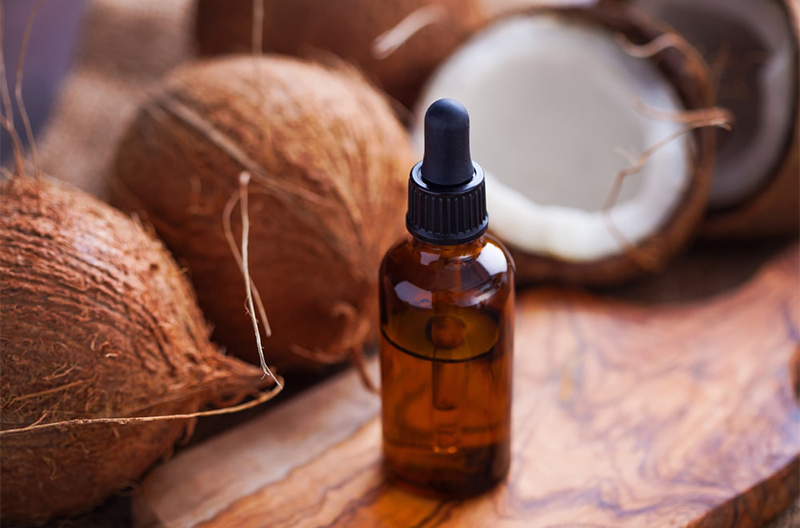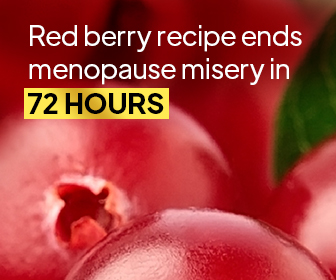Essential oils are useful medicinal and aromatic tools for your body and mind, and so is coconut oil! Coconut oil is an amazing carrier oil for your skin. Because pure essential oils should never be applied directly to your skin, coconut essential oil serves as a protective barrier to help your body safely absorb the diluted essential oils. Coconut oil can help moisturize your skin and hair, act as a mild UV protectant, and boost collagen.[1]’[2]’[3] Read on to see why you should be mixing essential oils with coconut oil topically and in aromatherapy.
Fractionated Coconut Oil vs. Virgin Coconut Oil
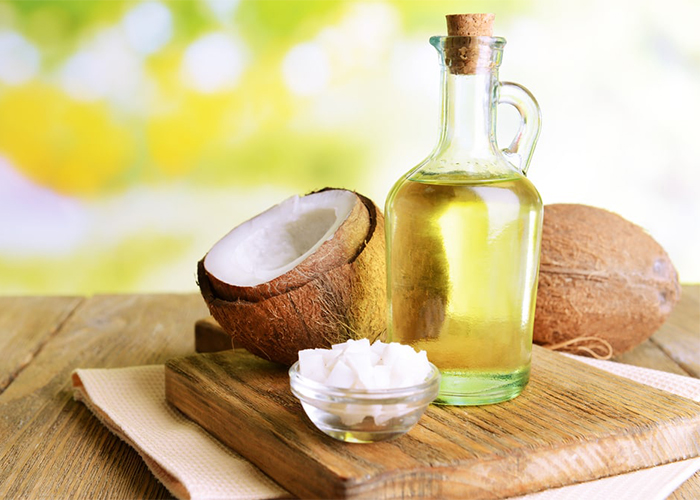
You might only know coconut oil as the cooking oil that gained popularity in recent years for its heart-healthy fats.[4] However, this oil is so much more than just something to add into a stir-fry. In fact, there are different types of coconut oil to look out for. To be more specific, two types of coconut oil are fractionated coconut oil and virgin coconut oil.
Fractionated coconut oil
When using coconut oil as a carrier oil for essential oils, you will want to primarily use fractionated oil. The fractionation process allows the oil product to be a more potent version of a saturated oil, with lighter feeling and smell.
Additionally, the fractionated coconut oil stays liquid at room temperature, allowing it to be ready to use in any case without re-heating as you might with standard coconut oil. Because it is a potent version of the original coconut oil, it may also contain higher rates of antioxidant and antimicrobial effects.
Virgin Coconut Oil
Standard virgin coconut oil is the most unprocessed form of the oil. Thus, it has more coconut aroma, flavor, and resemblance to the white, pulpy fruit it comes from. This oil is solid at room temperature and has a higher viscosity than the fractionated version. It is highly moisturizing, as is the fractionated oil, but virgin oil is less recommended for your face as it is thicker.
Also, virgin coconut oil is used more often in cooking. In terms of price, it is less expensive compared to fractionated oil because it goes through fewer processes. When mixing essential oils with coconut oil, virgin oil is a lesser alternative to fractionated oil.
What Makes Coconut Oil a Great Carrier Oil?
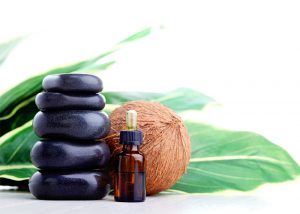
A carrier oil is basically just a weaker oil that can dilute the stronger, more potent essential oils. This way, the essential oils can absorb into your skin and body evenly and without irritation.
Fractionated coconut oil is a carrier oil because it is safe to use undiluted on your skin, and has a mild scent so as to not overpower the other essential oils. Still, there are many other great carrier oils out there too for different purposes. For example, almond oil is anti-inflammatory and immunity-boosting,[5] and jojoba oil contains antioxidants and is antibacterial.[6] So, what makes coconut oil a great carrier oil too?
Well, coconut oil is the perfect carrier oil if your skin or hair is in need of some serious hydration. Coconut oil protects the proteins in your hair, plus moisturizes and soothes your skin.[7]’[8] In fact, coconut oil proved to be slightly better than mineral oil at moisturizing skin in people with xerosis.[9] Not only that, coconut oil is a UV protectant as well. This makes coconut oil a light, moisturizing, and low SPF carrier to use in your daily routine.
Reasons Why You Should Mix Essential Oils With Coconut Oil
There are plenty of helpful health and wellness reasons to get you started mixing essential oils with coconut oil. This oil is beneficial all on its own but is even more helpful when working alongside the essential oils of your choice. Check out why you ought to be mixing essential oils with coconut oil to get the most out of your blends.
1. For topical safety
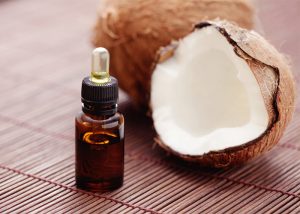
Any time you use an essential oil topically, you should dilute it first. This helps the essential oil spread out evenly on your skin. Not to mention, the essential oils are so potent that they may cause some skin irritation if they are used without a carrier oil. Coconut oil is a great carrier oil for safety because it spreads evenly on your body. Also, it absorbs into your skin quickly, so it won’t leave any residue on other parts of your body, hair, or surroundings.
2. To practice aromatherapy
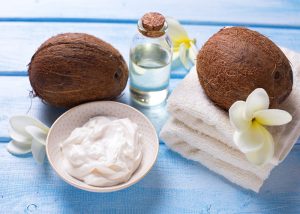
When diffusing essential oils, it is important to know what actually happens. Basically, you fill your diffuser with water and add in a few drops of essential oils. Then, the tiny essential oil particles disperse throughout the air along with the water.
The oil and water never actually mix, so you can still have slight reactions from the oils coming in contact with your skin or body if you’re not careful. Coconut oil is a great addition to your diffuser oils because it can mediate any harsh oils that you wouldn’t want to come into direct contact with.
To diffuse safely, first mix together the essential oils and coconut oil and shake well, then add that to your diffuser to ensure the blend will diffuse equally with the coconut oil mixed in. Check your diffuser for the exact amounts of essential oils you should add in at once.
3. In oil pulling to release toxins from your body
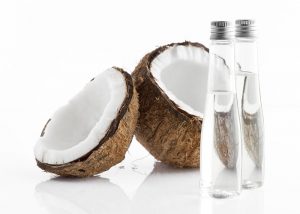
Oil pulling is a practice that draws out toxins from your body through a mouthwash-type rinse. You can practice oil pulling by swishing around coconut oil alone in your mouth for around 20 minutes.
Alternatively, you can make an upgraded coconut oil essential oil pull rinse with orange essential oil. Add in one drop of orange essential oil to two tablespoons of fractionated coconut oil. Swish around first thing in the morning for 20 minutes and spit out completely. Note that fractionated coconut oil congeals when cold so spitting out in the sink might mean clogging up your sink over time (especially in winter). Run hot water after use, or spit out in the trash instead.
How To Mix Essential Oils With Coconut Oil
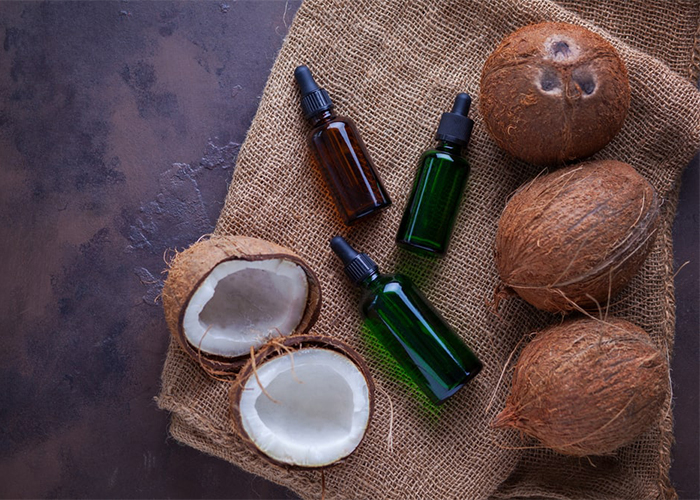
You should dilute all your essential oils before using them topically. It can also be helpful to use a carrier oil in some aromatherapy machines to help the oil diffuse evenly too. When testing out how to dilute essential oils with coconut oil, you should always be generous with the coconut oil until you know how your skin will react to the essential oils you use. Household brand DoTerra recommends one part essential oil for five parts minimum of their fractionated coconut oil.[10]
When mixing essential oils with coconut oil, you can use a variety of aromas to create your perfect blend. Fractionated coconut oil is nearly odorless. So, the sky is your limit in deciding what oils to blend together with this base. Mixing essential oils with unfractionated coconut oil is fine too. In that case, you’ll just have a stronger coconut smell that blends well with subtle florals like lavender and rose, as well as stronger tree-based aromas like pine or frankincense.
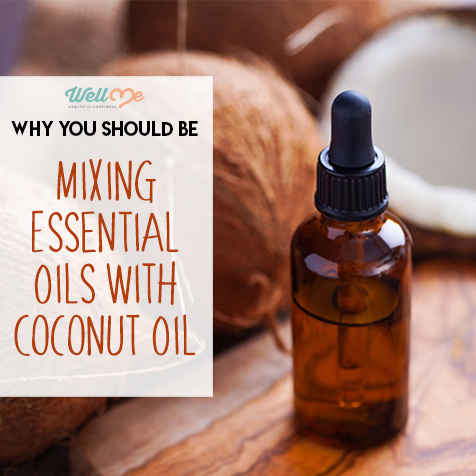
References
- [1] https://www.ncbi.nlm.nih.gov/pubmed/20523108
- [2] https://www.ncbi.nlm.nih.gov/pubmed/22279374
- [3] https://www.ncbi.nlm.nih.gov/pubmed/15724344
- [4] https://coconutboard.in/docs/English-Article-VCO-Carandang.pdf
- [5] https://www.sciencedirect.com/science/article/pii/S1744388109000772
- [6] https://patents.google.com/patent/US20040170712A1/en
- [7] https://www.ncbi.nlm.nih.gov/pubmed/15724344
- [8] https://www.ncbi.nlm.nih.gov/pubmed/12715094
- [9] https://www.researchgate.net/profile/Vermen_Verallo-Rowell/publication/8009961_A_Randomized_Double-Blind_Controlled_Trial_Comparing_Extra_Virgin_Coconut_Oil_with_Mineral_Oil_as_a_Moisturizer_for_Mild_to_Moderate_Xerosis/links/570e072d08aed31341cf91cf/A-Randomized-Double-Blind-Controlled-Trial-Comparing-Extra-Virgin-Coconut-Oil-with-Mineral-Oil-as-a-Moisturizer-for-Mild-to-Moderate-Xerosis.pdf
- [10] https://www.doterra.com/US/en/blog/spotlight-fractionated-coconut-oil

